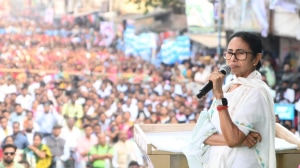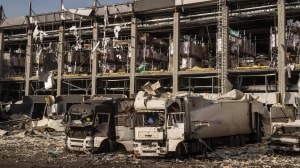Profit his engine, Lalu cuts fares, keeps key reforms still reserved
Sharp in short-term money making, strong in medium-term strategy, but weak in long-term vision, Railway Minister Lalu Prasad Yadav’s fourth Railway Budget 2007-08 chugs on the tracks he charted four years ago.

Sharp in short-term money making, strong in medium-term strategy, but weak in long-term vision, Railway Minister Lalu Prasad Yadav’s fourth Railway Budget 2007-08 chugs on the tracks he charted four years ago. It transports record-breaking profits and freight carriage; most importantly, it delivers the lowest-ever operating ratio. Lalu’s budget yearned for attention in the Lok Sabha — but he had to yell his way.
“Rs 20,000 crore,” he shouted. “We have made a record profit of Rs 20,000 crore,” as if this feat would silence an Opposition that had decided to let the Bofors gun drown his Budget. And if the Opposition didn’t dither, Lalu, the performer, didn’t yield an inch of the centrestage.
A surplus before dividends of Rs 20,000 crore makes Indian Railways the country’s biggest profit-making entity. To put it in perspective, the Railways’ profits are 25% more than the Rs 16,000 crore, the trailing 12-month profits of ONGC and almost double of Reliance Industries’ Rs 10,557 crore.
Keeping the speed at which it is growing and the magical “infrastructure” sector it is operating in mind, the Railways, if listed, would command a PE multiple of at least 20 times. Which means, at Rs 400,000 crore, it would be India’s most valued company, beating ONGC and Reliance by a margin of 100 per cent — and we’re not factoring its huge land banks.
Part of this success is operational. The 78.7% operating ratio (the ratio of expenses over revenues) is the lowest that the Railways has ever seen. According to Lalu, it is also among the world’s lowest.
The other success factor is strategic. This turnaround has been on display for the past three years, as Lalu’s policies of lowering unit costs has worked to remove productivity gaps in this once moribund organisation. On the freight front, the productivity jump has come from carrying more weight. This year, the 22.9 tonne and 25 tonne axle loads will be extended to more routes.
The Railways has also “restructured” its freight rates. For users, however, this means an “increase” in rates. While rates by themselves have not risen, clever manoeuvring from one classification to another has pushed rates higher.
Most of these, of course, are off-Budget, almost stealth operations, some of them inflationary. According to sources, in 2004, the cost of transporting urea was Rs 322.60 per tonne for 600 km. This rose by 33% to Rs 430.10 in 2006. Or take foodgrains, where Railway earnings rose by 17% between 2005-06 and 2006-07, from 56.33 paise per net tonne km (NTKM) to 66.38 paise per NTKM.
On the passenger front, the turnaround has been led by carrying more passengers — last year, the Railways added 700 additional coaches on popular routes, this year 800 more coaches will be added, bringing smiles to coach makers like Texmaco but while this restructuring has not so far converted into profits, losses are on their way down.
The number of passengers carried rose by 7% to 6.2 billion, while passenger earnings increased by 15% to Rs 17,400 crore. In 2007-08, while the number of passengers will rise by 6%, earnings are expected to grow by 15%. This, again conforms to Lalu’s unit-cost strategy — raise the number of passengers carried on marginally increased coach infrastructure.
The consistency in Lalu’s budgets remains. While turning the organisation financially viable remains an important priority, this priority has been serviced keeping competition and customers in mind.
To fight the airlines for the top end of its “self paying” customers, for instance, Lalu has reduced the price of passenger fares by 3-6% for AC first class, 2-4% in AC 2-tier class, and 4-8% in AC 3-tier. While this will not prompt the Deccans and the Jets to lower their fares further, the pressure on their bottomlines just increased.
The other point where Lalu is challenging airlines is on service and this is where he may trip. It is not enough to hand out a national 139 call centre number or announce 2007-08 as “Cleanliness Year” to deliver service. There are enough numbers already and they barely work, and clean stations, clean coaches seem to be an oxymoron.
Increasing expectations on the services front could well be his Achilles’ Heel, for like it or not, to deliver state-of-the-art service, you need a different breed of people, not current incumbents. But in all fairness, we wait.
On the freight side, the fight is not on fares but on convenience. Through a strategic incentive play on time — again, to be able to carry more load and lower unit cost — the Railways is encouraging reduction in downtime and sharing the benefit with its end users.
For instance, trains that lie unloaded for hours, if emptied within a stipulated period, give concessions to the client. Or, if there’s an empty train returning from a particular destination, discounts of upto 40% are being offered in incremental loading.
What Lalu’s fourth Budget misses out is investments. On that front, what we have are impressive announcements — the Rs 60,000-crore Dedicated Freight Corridor, building high-density networks, new electric loco works at Madhepura and the Wagon bogie complex at Dalmia Nagar.
Their financing remains an important question. If PPP (public-private partnership) is the way forward, as Lalu says, he must remember it is one thing to have Rs 50-lakh – Rs 10-crore PPPs, as he has successfully implemented in catering, but it is quite another to service the scale the Railways need.
When the stakes are in thousands of crores of rupees, factors like long-term viability, user charges, management control, fiscal incentives, speed of operations, return on investment and suchlike come into play. Also, the world over, the private sector is not too enthused about investing in ground infrastructure — it just doesn’t pay enough. But no thought seems to have gone in this direction in this Budget.
The Dedicated Freight Corridor, for instance, has been hanging fire for a long time. Even the search committee has not been finalised, nor, because of control and turf issues, is it likely to in the near term. This corridor, if it moves along the PPP way, needs not only pipelines of finance, but operational freedom, autonomy, a board with equal representation from the private sector — a bullet that even Lalu may not be quite ready to bite just yet, and one that his Budget doesn’t address.



- 0118 hours ago
- 021 day ago
- 031 day ago
- 0417 hours ago
- 051 day ago




























